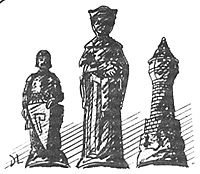
One evening aoout a year ago now, I was planning to play a game of Panaerblitz with a friend. That morning another game-playing friend from out of town showed up. What to do? Among the dozens of games there wasn't one I really enjoyed playing with three people. Sound familiar? I thought for a while about the problem, and came up with a pair or games which I enjoy.
What are the normal options for three? You can make an enforced coalition, say England and Prussians in Waterloo. Then play a two person game with two commanders sharing one side. But that's not a game designed for three. Then there are the multiplayer games designed for five or more. They can be scaled down for three-- Diplomacy, Risk, Origins, Emperor of China... These games are usually best with the designed limit of players, and reasonable for one less. Nothing for three or less on the shelf!
Gang Factor
I believe the basic problem is this: In a symmetric game for three players, any coalition of two is completely overpowering against the third. By symmetric, I mean roughly equal forces, and similar goals. It is very hard for one player to get stronger than both of the others, even if he is much better than either. When there are more players in a game, If a coalition of two attacks a third, the third can get an ally himself. Also, since coalitions larger than two are much less stable, it becomes harder to "gang up" against the leading player.
This analysis suggested examining asymmetric games for three. The two possibilities are two small forces and one large force, and two large forces and one smail one. Both have given interesting games. If there are two small players, they should be designed to balance each other, and together they should balance or slightly exceed the strennth of the third. The large player wins if he turns the balance to his favor, else the larger of the two smalls wins. With two players, they must be balanced while the small holds the overall balance of power. For one of the players to win, he must obtain the lead. If no large can do this, the small wins.
There are many ways in which these asymmetric games can be embodied, but the player dynamics are the most Important thing. Because this is their point, an embodiment in the Diplomacy structure is quite natural.
The balance of power game works well (and historically even) by having the small player control England. One large player manages the forces of Germany, Italy, and Turkey. The second large player has the rest (Russia, Austria-Hunnary, and France). The groupings have been chosen to maximize conflict between the large players, The game is exactly five years long being scored after the territorial adjustments of the last year.
For a large player to win, he must have more than half of the supply centers ... otherwise England wins. Note the England can win even if his pieces are completely eliminated. So he should continue to play, offering advice and misadvice to the end if that happens.
For a game with two smalls, give one player France and Austria-Hungary, and the other player Germany and Italy. The large has England, Russia, and Turkey. The two smalls have two centers more to start with, but the large has all the countries with no backfield problems. It is so obvious that the two smalls must work together in this setting, that it is necessary to build In all the conflict possible between them. The geme is again exactly five years long. The large player wins by having half of more of the supply centers. If the large player does not have half, then the larger of the smalls wins. If they are equal, then the game is drawn between all three players. This provision again discourages the natural coalition.
Of these games, I prefer the balance of power. It seems to bring more diplomacy and shifting alliances. The other gives plenty of diplomacy, with the large player supporting one small at one place and the other at another. The balance of power game cannot be drawn, and it turns out unlikely that England is eliminated.
A quite different embodiment is in chess. Give the third player one king. He starts the game by placing his piece on the board. Then follow white and black as usual. The third king can be prevented from moving by checkmate or stalemate, but cannot be taken. When (if) the condition is relieved, he can move again. If either black or white king is checkmated the other player wins. If a normally drawn situation results, the third player wins. To preserve the chess-like atmosphere, this game should be played without diplomacy.
Other embodiments of the situations are possible.
Back to Table of Contents -- Panzerfaust # 60
To Panzerfaust/Campaign List of Issues
To MagWeb Master Magazine List
© Copyright 1973 by Donald S. Lowry.
This article appears in MagWeb (Magazine Web) on the Internet World Wide Web.
Other military history articles and gaming articles are available at http://www.magweb.com